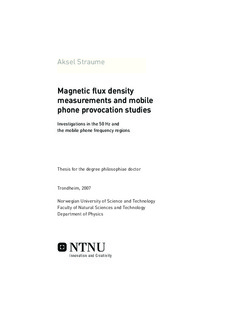| dc.contributor.author | Straume, Aksel | nb_NO |
| dc.date.accessioned | 2014-12-19T13:16:00Z | |
| dc.date.available | 2014-12-19T13:16:00Z | |
| dc.date.created | 2007-06-28 | nb_NO |
| dc.date.issued | 2007 | nb_NO |
| dc.identifier | 123050 | nb_NO |
| dc.identifier.isbn | 978-82-471-2517-5 | nb_NO |
| dc.identifier.uri | http://hdl.handle.net/11250/246177 | |
| dc.description.abstract | The aims of this thesis work were divided into two main areas. The first area was an investigation of the extremely low frequency magnetic fields in urban environment and from electrical devices. The second area was mobile phone provocation studies to investigate skin temperature increase and headaches attributed to mobile phone use. The magnetic flux density was measured along 17 km of pavement in an urban area of Trondheim.
The magnetic flux density in summer was quite small compared to other cities (mean value 0.13 μT). In winter when it snows, the mean value of the magnetic flux density was almost seven times greater (0.90 μT) compared to summer conditions. The two main reason for the increased magnetic flux density in winter are increased power consumption due to electrical indoor heating and electrical heating of the pavement to get rid of snow and ice. The highest recorded measurements above net stations in pavement were higher in Trondheim than in other cites (37 μT). The basic restrictions were not exceeded.
Spectral measurements on electrical devices showed that the spectral distribution of the current drawn to the device does not necessarily reflect the spectral distribution of magnetic flux density around the device. Mapping of the magnetic flux densities around mobile phones was emphasized.
Skin temperature measurements after mobile phone use showed that there was a statistically significant temperature rise on the cheek and on the ear. However, this temperature rise was found to be mainly caused by insulation and impeded convection prevention of convection which the mobile phone device itself causes. There was not a significant additional heating by the RF-radiation emitted.
In a double blind provocation study, all subjects who went through a mobile phone provocation study reported typical headache symptoms at an open selection test for participation in the study. The study consisted of 65 pairs of double blind tests. The result did not give any evidence that RF fields caused any pain or discomfort in the head. Subjects displayed symptoms at both RF-exposure and SHAM-exposure and the result could most likely be explained by negative expectations, i.e. a nocebo effect. There was no statistically significant change in heart rate and/or blood pressure. | nb_NO |
| dc.language | eng | nb_NO |
| dc.publisher | Fakultet for naturvitenskap og teknologi | nb_NO |
| dc.relation.ispartofseries | Doktoravhandlinger ved NTNU, 1503-8181; 2007:114 | nb_NO |
| dc.relation.haspart | Straume, Aksel; Johnssson, Anders; Oftedal, Gunnhild; Wilén, Jonna. Frequency spectra from current- vs. magnetic flux density measurements for mobile phones and other electrical appliances. Health Physics. (ISSN 1538-5159). 93(4): 279-287, 2007. | nb_NO |
| dc.relation.haspart | Straume, Aksel; Oftedal, Gunnhild; Johnssson, Anders. Skin Temperature Increase Caused by a Mobile Phone. Bioelectromagnetics. 26(6): 510-519, 2005. | nb_NO |
| dc.relation.haspart | Oftedal, Gunnhild; Straume, Aksel; Johnssson, Anders; Stovner, Lars Jacob. Mobile phone headache: a double blind, sham-controlled provocation study. Cephalalgia. 27: 447-455, 2007. | nb_NO |
| dc.title | Magnetic flux density measurements and mobile phone provocation studies: Investigations in the 50 Hz and the mobile phone frequency regions | nb_NO |
| dc.type | Doctoral thesis | nb_NO |
| dc.contributor.department | Norges teknisk-naturvitenskapelige universitet, Fakultet for naturvitenskap og teknologi, Institutt for fysikk | nb_NO |
| dc.description.degree | PhD i fysikk | nb_NO |
| dc.description.degree | PhD in Physics | en_GB |
